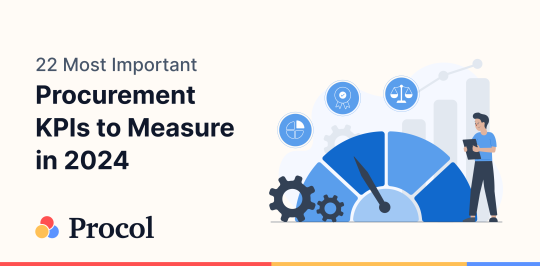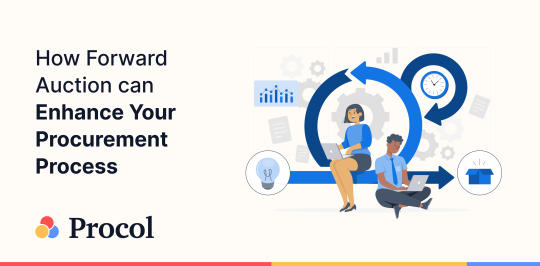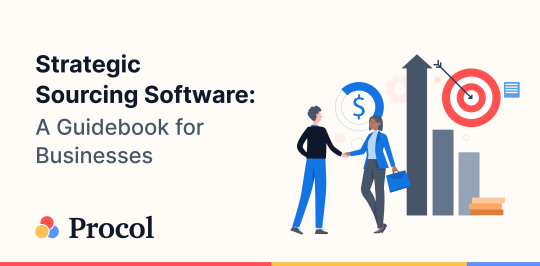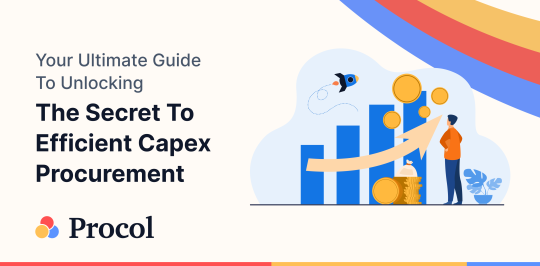22 Most Important Procurement KPIs to Measure in 2024
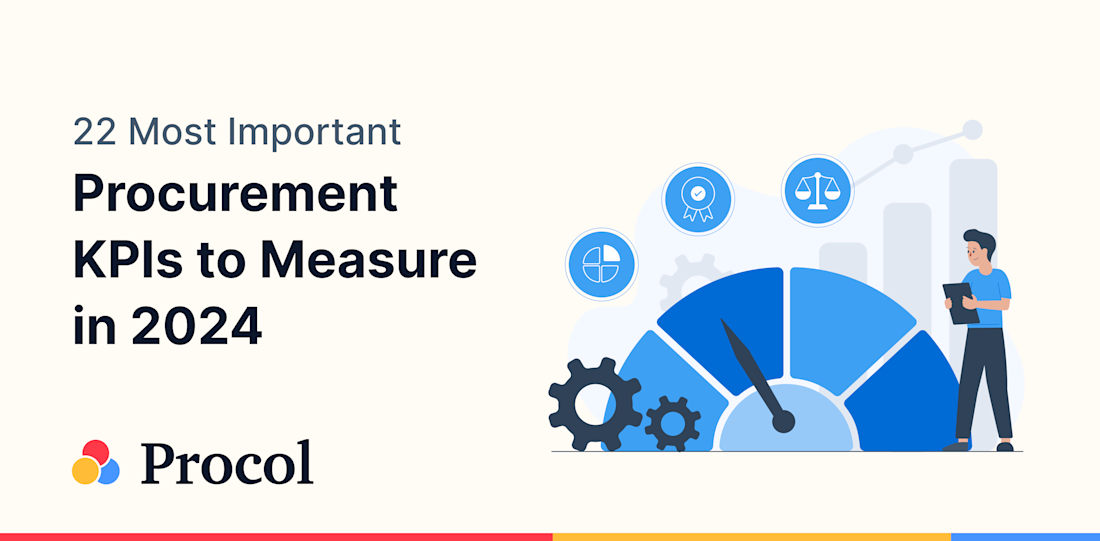
TABLE OF CONTENTS
- Introduction
- How does the procurement process work?
- What is the need for procurement KPIs?
- What are the types of procurement?
- What are the five Key Performance Indicators for procurement?
- What are the KPIs and metrics to measure procurement performance?
- KPIs for the purchasing department
- How does procurement software improve your procurement process?
Introduction
Procurement is a popular term in the business world as it is the most important aspect of improving operational efficiency. Industries operating in manufacturing, transportation and logistics, construction, and retail sectors can achieve business objectives by successfully implementing procurement.
The size of the procurement as a service market was estimated at USD 5.52 billion in 2021 and is expected to increase at a CAGR of 11.1% from USD 6.15 billion in 2022 to USD 14.62 billion by 2030.
In simple terms, procurement is the process of procuring, acquiring, and buying goods or services for a business. Implementing the procurement process effectively and measuring its performance becomes easy using procurement key performance indicators. Let’s understand these procurement KPIs to accelerate your operational efficiency.
How does the procurement process work?
Procurement is often considered the backbone of supply chain management. Procurement streamlines operational work, but what is the process of procurement?
Let’s understand here in brief:
- Considering internal demands, it identifies products or services that any business may need for its projects and operational work.
- The process is further advanced by clarifying requirements about the needed goods or services in terms of quality, quantity, cost, etc. Businesses must then create a purchase request and have it reviewed by their concerned department.
- Once the purchase request is approved, brands identify potential suppliers to fulfill their requirements. A Request For Quotation (RFQ) is issued to all the suppliers, including all necessary details regarding their requirements to ensure organizational success.
- After getting all the inputs and RFQ from a business, suppliers send back their proposals. The procurement team evaluates suppliers’ proposals based on various crucial factors.
- After finalizing a supplier, the procurement team negotiates. Various factors, including price, quality, contractual agreements, etc., are reviewed and discussed with potential suppliers before the team finalizes one.
- Once the processes are completed, the procurement team issues purchase orders to suppliers, mentioning all details. After this, the supply side starts fulfilling the orders, and the procurement team monitors them.
- Finally, the procurement team reviews the invoice sent by the supplier and makes the final payment.
- They are also supposed to keep track of all the papers related to the procurement procedure.
What is the need for procurement KPIs?
Procurement KPIs matters for:
KPIs enable businesses to monitor and assess the performance of their procurement function. Metrics like cost savings, supplier performance, cycle times, etc., help businesses understand how they function in general.
KPIs enable businesses to align procurement activities with organizational goals and objectives. By tracking specific metrics, businesses can decide how to meet their goals.
KPIs enable businesses to gain data-driven insights that help them identify improvement areas, optimization opportunities, and potential risks within the procurement process.
KPIs enable businesses to evaluate and manage their relationships with suppliers effectively. This includes assessing factors like quality, delivery times, compliance, and overall value provided by suppliers.
KPIs enable businesses to identify trends, patterns, and areas for improvement in their procurement processes. This fosters a culture of continuous improvement and optimization within the procurement function.
KPIs enable businesses to gauge their competitiveness and identify areas for improvement. By benchmarking against industry standards, businesses can improve their overall functions and work processes.
KPIs enable businesses to reduce the risks associated with procurement activities. This further helps them function efficiently and meet overall objectives and goals.
What are the types of procurement?
Direct procurement
Direct procurement is buying goods, raw materials, or services from suppliers to produce goods or services within the company. Typically, manufacturing companies use direct procurement. Steel, hardware, software, electric items, etc., are raw materials purchased through direct procurement.
One must be very careful while procuring, as careless procurement can lead to overstock or understock. The idea behind direct procurement is to earn profit and build relationships with suppliers.
Indirect procurement
In indirect procurement, goods for operation purposes are bought. The purchase of goods or services required for day-to-day operational tasks is indirect procurement.
Repair services, office suppliers, IT hardware and software, etc., are examples of indirect procurement. Cost, inventory, delivery, and quality KPIs are categorized as examples of indirect procurement KPIs.
Spending under management, purchase order cycle, inventory turnover, and other indirect procurement key performance indicators are included. Some of the more important KPIs are discussed below.
Services procurement
Services procurement is the process of outsourcing services required to meet business needs and achieve business objectives. Consulting, marketing, IT services, and many more can be procured to fulfill business requirements.
It involves figuring out the needed services first, choosing trusted vendors, and negotiating contracts. However, various e-procurement software services make the procurement process easy.
Goods procurement
Goods procurement is the buying of physical goods for business requirements. Whether it is direct or indirect procurement depends on the requirement. Right planning and forecasting are crucial for effective goods procurement. Metals, office equipment, glasses, etc., are procurement items for goods.
What are the five Key Performance Indicators for procurement?
-
Cost savings - to measure the money saved through strategic sourcing, negotiations with suppliers, and cost-effective procurement practices.
-
Supplier performance - to evaluate suppliers based on criteria such as delivery timeliness, quality of goods/ services, responsiveness, adherence to contract terms, and overall relationship management.
-
Purchase order cycle time - to track the time taken to process purchase orders from requisition to approval, aiming to reduce cycle times and improve procurement efficiency.
-
Spend analysis - to analyze spending patterns, trends, and categories to identify opportunities for cost reduction, supplier consolidation, and strategic sourcing initiatives.
-
Compliance and risk management - To ensure compliance with contract terms, conditions, and pricing agreements, minimizing risks associated with contract deviations and non-compliance.
What are the KPIs and metrics to measure procurement performance?
Supplier KPIs
Supplier KPIs measure supplier performance. This is essential for streamlining the procurement process and achieving maximum efficiency and profit.
- Number of suppliers
Dealing with an adequate number of suppliers is essential in a smooth procurement process. Over-excess or insufficiency is always alarming. Excess suppliers can affect discount possibilities from suppliers and create complexity in the working process. Having less number of suppliers is also problematic, as it can cause overdependence on a single or few suppliers, leading to less diversity and disruption in the supply process, etc. One must utilize this procurement key performance indicator effectively.
- Delivery time
Delivery time is the time the supplier takes to deliver goods, measured from the ordered date to the delivery date. It is never advisable to use suppliers who frequently deliver orders late because this reduces operational efficiency. Monitoring this essential procurement KPI helps identify any bottlenecks or inefficiencies.
On-time delivery shows that the supplier is trustworthy and efficient. Using real-time tracking systems and the best procurement software helps measure these procurement performance metrics successfully, which helps maintain long-term relationships with the right supplier.
- Supplier defect rate
Supplier defect rate is the percentage of goods found to be defective, i.e., goods that fail to meet predefined product requirements. High supplier defect rates cause production delays and excess costs, especially in manufacturing, aerospace, automotive, and tech industries.
Statistical process control helps identify defects and implement effective solutions. These procurement key performance indicators should be reviewed regularly to avoid supplier defect rates.
Supplier defect rate = Number of defective items/ total items received.
- Contract compliance rate
A high compliance rate indicates that the supplier meets the expectations mentioned in the agreement. Product quality, quantity, delivery time, and other essential factors are part of the contract. A decline in the compliance rate KPI increases indirect compliance.
To maintain a high contract compliance rate (a procurement key performance indicator), the procurement team can practice frequent performance reviews, cautious issue resolution, and transparent communication about requirements. Constant monitoring of these procurement key performance indicators can identify areas for improvement and optimization.
- Vendor rejection rate and costs
The vendor rejection rate measures the percentage of damaged goods that didn’t match quality expectations and other mentioned needs. It is recommended that the reason for the high vendor rejection rate be identified and that a strategic approach be implemented to leverage supplier performance.
Cost is an important KPI in supplier management. Monitoring it results in cost reduction, better negotiation, and good discounts. Properly analyzing these procurement performance metrics streamlines the procurement process.
Staff KPIs
Monitoring procurement KPIs accelerates operational work efficiency. For the procurement department, measuring these KPIs helps identify issue areas and understand which area of business needs more attention.
Below are the KPIs for the procurement department to accelerate success:
- Spend under contract
Spending under contract is the percentage of the business’s overall spending controlled by contracts with suppliers. Proper control of cost spending avoids overspending and reduces risk. Strategic decisions and budget forecasting can achieve a high spending under contract rate. Along with cost control, negotiation also requires terms and conditions and control over the management process.
Spend under contract = (Total spend covered by contracts/ total procurement spend) ×100
- Lead time
Low lead time indicates the business is working seamlessly. It is the time interval between starting the purchase activity and receiving the purchased goods. It defines the efficiency of the supply chain. High lead time can indicate missed delivery deadlines and inventory stockouts, which affect the business.
Monitoring and examining lead time to identify problems and take immediate action for improvement is recommended.
Actual order lead time = Delivery date - order entry date
- Purchases on time and within budget
It is one of the important KPIs for the procurement manager to monitor. It helps them identify loopholes in the procurement process. Right communication with suppliers, coordination, budget forecasting, and strategic planning ensure purchases are on time and within budget.
Some e-procurement software like Procol helps streamline procurement processes and leverage efficiency.
- Purchase order cycle time
The purchase order cycle time is the time between a purchase request and its delivery to the contractor or supplier. It’s a timeline between the request made and the request fulfilled. Reduced purchase order cycle time leverages customer satisfaction and indicates a streamlined procurement process.
Some useful practices include setting realistic targets, selecting the right suppliers, using e-procurement platforms, and monitoring and analyzing purchase order cycle time.
Purchase order cycle time = Date of purchase order issuance − date of purchase requisition submission
- Rate of emergency purchases
Emergency purchases in a business occur sometimes, but frequent emergencies may indicate a lack in the procurement process.
Here are some negative aspects of emergency purchases:
- Compromised quality due to limited time
- Disrupt production, operations
- Disrupt supply chain flow
- Additional costs
Rate of emergency purchases = (Number of emergency purchases / total number of purchases) x 100%
Operational KPIs
- Procurement ROI
The procurement ROI KPI measures the effectiveness of a company’s procurement process. Every business wishes to have a high procurement ROI.
Best practices for high procurement ROI:
- Defining and tracking performance metrics
- Total cost of ownership analysis
- Process automation through tech platform
- Supplier performance management
- Building strong relationships with the supplier
- Inventory turnover
Inventory turnover measures how frequently a company sells and replaces its stock during a specified period. This procurement key performance indicator is most useful in the retail industry. It indicates the rate at which inventory is turned into sales for a business.
Low turnover can result from ineffective marketing, inefficient supply chain, slow-moving products, inaccurate demand forecasting, long lead time, etc. Increasing inventory turnover indicates an effective supply chain, which results in fulfilling customer demand. It is calculated as:
Inventory turnover = Cost of goods sold/ average inventory value
- Inventory accuracy
Inventory accuracy measures the difference between a well-recorded inventory level and the actual amount of physical inventory on hand. Inaccuracy in data entry can disrupt inventory accuracy. Regularly monitoring these procurement performance metrics helps detect issues and take immediate action.
Inventory accuracy = (Stock count/ recorded stock count) x 100
Radio-frequency identification (RFI), barcode scanning, and an automated inventory management system are recommended to improve inventory accuracy.
- Cost per invoice
Cost per invoice is the internal expense incurred during the invoice processing process. Big businesses often calculate this procurement KPI, while small businesses usually don’t. Low cost per invoice is always considered good and signifies streamlined working processes. High cost per invoice, which every business tries to avoid, can occur because of high invoice volume, lack of automation, inability to utilize tech solutions, complex approval workflows, etc.
The time taken to track the opportunity, employee pay, and the building/facility’s power are the three primary data components inventory turnover includes.
- The ratio of spending to sales revenue
The spending ratio to sales revenue gives insights into a business’s sales revenue. This ratio helps to effectively understand the effectiveness of strategies and budget distribution decisions. A lower spending-to-sales revenue ratio indicates that the business is profitable. Utilizing e-procurement tools and enterprise resource planning systems eases the tracking of spend and sales data in the most accurate way.
The spending to sales revenue ratio = (Cost of selling / total value of sales) x 100.
As mentioned above, key performance indicators are key to the success of an effective procurement process. If monitored and analyzed correctly, these procurement KPIs for managers and officers can easily contribute to meeting organizational goals. The procurement officer tracks key performance indicators for the procurement departments, such as staff performance, POC, spending under contract rate, etc., to ensure streamlined processes.
Tracking supplier, staff, and operational KPIs is a key performance indicator for procurement officers and managers. They often utilize the results to increase operational efficiency and streamline work.
KPIs for the purchasing department
Tracking and analyzing KPIs for the purchasing department is crucial as it boosts making the right finance-related decisions, offers cost-saving opportunities, and identifies issues that allow immediate action before any major incident happens. It indicates purchasing KPIs for the department and includes all procurement key performance indicators related to costs, purchases, etc.
Here’s a short brief on purchasing metrics and KPIs:
- Purchase order cycle: The time between a purchase request being made and given to the contractor or supplier.
- Purchase in time and budget: Businesses must purchase goods in a predefined time and budget.
- Purchase order accuracy: Percentage to which purchase orders are error-free.
- Emergency purchase ratio: Maintaining a low emergency purchase ratio is always good.
How does procurement software improve your procurement process?
E-procurement software streamlines procurement processes and provides overall growth to the business. Strategic sourcing is one of the major benefits that strategic sourcing KPIs can calculate. Similarly, inventory optimization, increased productivity, improved accuracy, cost savings, time savings, reduced unauthorized spending, and competitive edge are other highlighting benefits of utilizing e-procurement software.
Procol is your ideal e-procurement software. It provides user-friendly software and features like insightful reports, real-time data, and more, ultimately ensuring your business’s success.
Founded in 2018, Procol is an ideal reverse auction website in India, securely deployed at many $1B global companies. It has helped procurement teams reduce costs and digitize procurements with top-notch tools and services. Procol has various unmatched features and capabilities, making it the best procurement management software for your system.
What works for Procol:
- Next-generation platform to get all your spending under control and ultimately gain 2-10% cost savings
- Saved 15,000 hours by automating tedious procurement tasks for 100+ global enterprises
- $100M+ generated savings by Procol customers
- Empower teams with a dedicated mobile-first approach. It ensures procurement professionals have the flexibility to drive efficiency wherever they are.
- Businesses gain the flexibility of customizable workflows and templates that meet precise organizational need
- Gives access to 50,000+ suppliers registered and onboarded globally
- Intuitive interface and unmatched efficiency ensure quick setup
- Streamlines capex sourcing for maximum efficiency
- Integrates seamlessly with ERP systems to smoothen procurement operations
Get a Free Demo
We'd love to hear from you. Please fill out this form to schedule a demo with us. You can also give a call on +91 76666 82222


